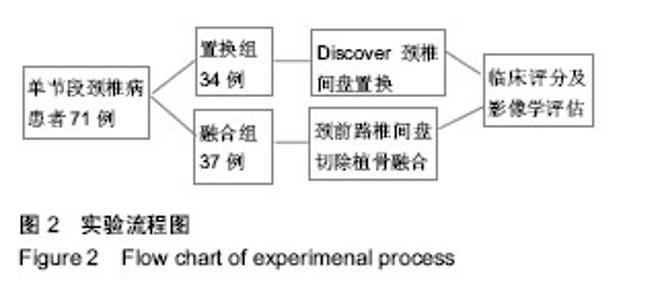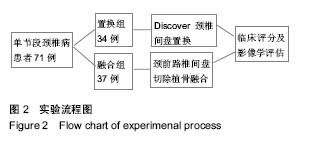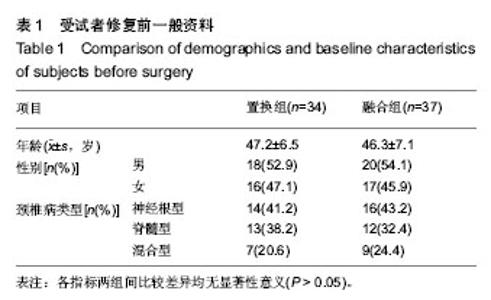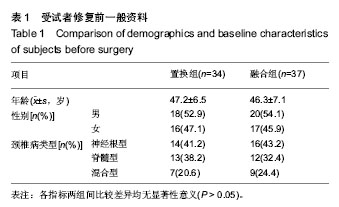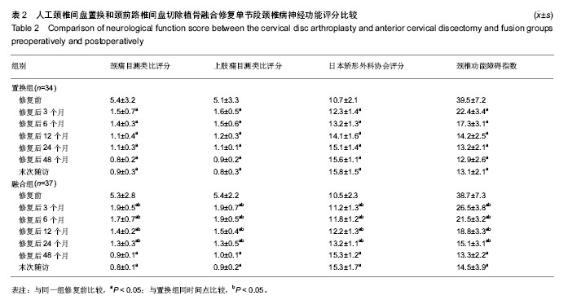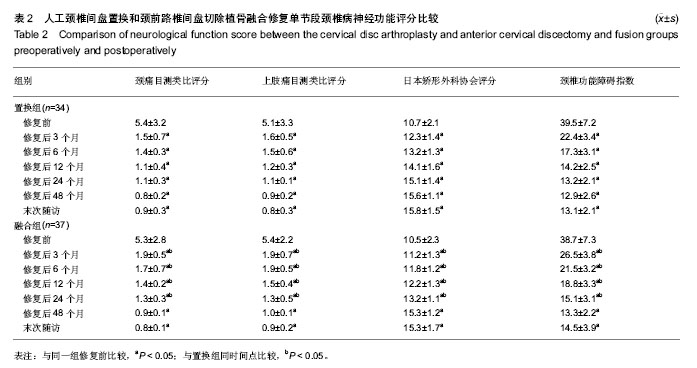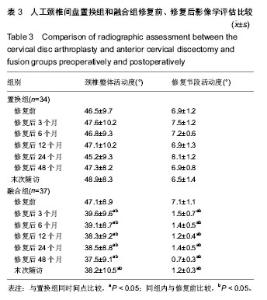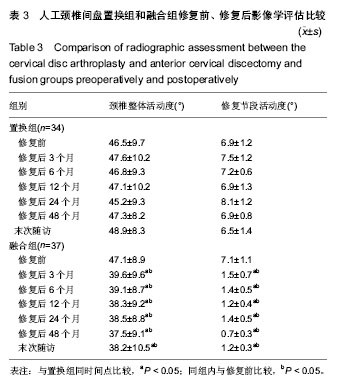| [1] Goffin J, Geusens E, Vantomme N, et al. Long-term follow–up after interbody fusion of the cervical spine. J Spinal Disord Tech. 2004;17(2):79-85.
[2] Grob D, Porchet F, Jeszenszky D, et al. A comparison of outcomes of cervical disc arthroplasty and fusion in everyday clinical practice: surgical and methodological aspects. Eur Spine J. 2010;19(2):297-306.
[3] Yue WM, Brodner W, Highland TR. Long-term results after anterior cervical discectomy and fusion with allograft and plat-ing: a 5- to 11-year radiologic and clinical follow-up study. Spine. 2005;30(19):2138-44.
[4] Riew KD, Buchowski JM, Sasso R, et al. Cervical disc arthroplasty compared with arthrodesis for the treatment of myelopathy. J Bone Joint Surg Am. 2008;90(11):2354-2364.
[5] Kim SW, Limson MA, Kim SB, et al. Comparison of radiographic changes after ACDF versus Bryan disc arthroplasty in single and bi-level cases. Eur Spine J. 2009; 18(2):218-231.
[6] Baba H, Furusawa N, Imura S, et al. Late radiographic findings after anterior cervical fusion for spondylotic myeloradiculopathy. Spine. 1993;18(15):2167-2173.
[7] Hilibrand AS, Robbins M. Adjacent segment degeneration and adjacent segment disease: the consequences of spinal fusion? Spine J. 2004;4(6 suppl):190s-194s.
[8] Singh K, Phillips FM, Park DK, et al. Factors affecting reoperations after anterior cervical discectomy and fusion within and outside of a federal drug administration investigational device exemption cervical disc replacement trial. Spine J. 2012;12(5):372-378.
[9] Mummaneni PV, Haid RW. The future in the care of the cervical spine: interbody fusion and arthroplasty. Invited submission from the joint section meeting on disorders of the spine and peripheral nerves, March 2004. J Neurosurg Spine. 2004;1(2):155-159.
[10] Chen J, Wang X, Bai W, et al. Prevalence of heterotopic ossification after cervical total disc arthroplasty: a meta-analysis. Eur Spine J. 2012;21(4):674-680.
[11] Leung C, Casey AT, Goffin J, et al. Clinical significance of heterotopic ossification in cervical disc replacement: a prospective multicenter clinical trial. Neurosurgery. 2005; 57(4):759-763.
[12] Yang YC, Nie L, Cheng L, et al. Clinical and radiographic reports following cervical arthroplasty: a 24-month follow-up. Int Orthop. 2009;33(4):1037-1042.
[13] Heller JG, Sasso RC, Papadopoulos SM, et al. Comparison of BRYAN cervical disc arthroplasty with anterior cervical decompression and fusion: clinical and radiographic results of a randomized, controlled, clinical trial. Spine. 2009;34(2): 101-107.
[14] Fernstrom U. Arthroplasty with intercorporal endoprothesis in herniated disc and in painful disc. Acts Chir Scand Suppl. 1966;357(1):154-159.
[15] Sasso RC, Anderson PA, Riew KD, et al. Results of cervical arthroplasty compared with anterior discectomy and fusion:four-year clinical outcomes in a prospective, randomized controlled trial. J Bone Joint Surg Am. 2011;93(18): 1684- 1692.
[16] Burkus JK, Haid RW, Traynelis VC, et al. Long-term clinical and radiographic outcomes of cervical disc replacement with the prestige disc: results from a prospective randomized controlled clinical trial. J Neurosurg Spine. 2010;13(3):308- 318.
[17] 张雪松,张永刚,王岩,等.单节段人工椎间盘置换治疗颈椎病的中长期疗效[J].中国脊柱脊髓杂志,2012,22(10):879-883.
[18] Fehlings MG, Smith JS, Kopjar B, et al. Perioperative and delayed complications associated with the surgical treatment of cervical spondylotic myelopathy based on 302 patients from the AOSpine north America cervical spondylotic myelopathy study. J Neurosurg Spine. 2012;16(5):425-432.
[19] Zigler JE, Delamarter R, Murrey D, et al. ProDisc-C and anterior cervical discectomy and fusion as surgical treatment for single-level cervical symptomatic degenerative disc disease. Spine. 2013;38:203-209.
[20] 贡雯韵,袁文,侯洋,等. Discover颈人工椎间盘置换治疗颈椎病的临床研究[J].中国脊柱脊髓杂志,2013,23(1):11-15.
[21] Rozankovic M, Marasanov SM, Vukic M. Cervical disc replacement with discover versus fusion in a single level cervical disc disease: a prospective single center randomized trial with a minimum two-year follow-up. J Spinal Disord Tech. 2014;9(8):1-20.
[22] Garrido BJ, Taha TA, Sasso RC. Clinical outcomes of bryan cervical disc arthroplasty a prospective, randomized, controlled, single site trial with 48-month follow-up. J Spinal Disord Tech. 2010;23(6):367-371.
[23] Yu L, Song YM, Yang X, et al. Systematic review and meta-analysis of randomized controlled trials: comparison of total disk replacement with anterior cervical decompression and fusion. Orthopedics. 2011;34(10):e651-e657.
[24] Goffin J, van Loon J, Van Calenbergh F, et al. A clinical analysis of 4- and- 6- year follow-up results after cervical disc replacement surgery using the Byran Cervical Disc Prosthesis. J Neurosurg Spine. 2010;12(3):261-269.
[25] Coric D, Kim P, Clemente JD, et al. Prospective randomized study of cervical arthroplasty and anterior cervical discectomy and fusion with long-term follow-up: results in 74 patients from a single site. J Neurosurg Spine. 2013;18(1):36-42.
[26] 田伟,吕艳伟,刘亚军,等.中国大陆人工颈椎间盘置换修复后异位骨化发生率的Meta分析[J].中华骨科杂志,2013,33(8):785-791.
[27] Anderson PA, Sasso RC, Riew KD. Comparison of adverse events between the Bryan artificial cervical disc and anterior cervical arthrodesis. Spine. 2008;33(12):1305-1312.
[28] Fountas KN, Kapsalaki EZ, Nikolakakos LG, et al. Anterior cervical discectomy and fusion associated complications. Spine. 2007;32(21):2310-2317.
[29] Jawahar A, Cavanaugh DA, Kerr EJ 3rd, et al. Total disc arthroplasty does not affect the incidence of adjacent segment degeneration in cervical spine: results of 93 patients in three prospective randomized clinical trials. Spine J. 2010; 10(12):1043-1048.
[30] Nunley PD, Jawahar A, Kerr EJ 3rd, et al. Factors affecting the incidence of symptomatic adjacent-level disease in cervical spine after total disc arthroplasty: 2- to 4-year follow-up of 3 prospective randomized trials. Spine. 2012;37(6):445-451.
[31] Yin S, Yu X, Zhou SL, et al. Is Cervical disc arthroplasty superior to fusion for treatment of symptomatic cervical disc disease? A meta–analysis. Clin Orthop Relat Res. 2013;471 (6): 1904-1919. |
